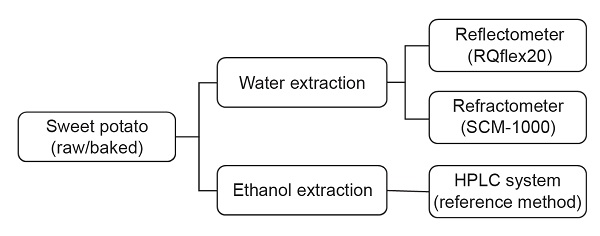Current issue
Author:Hui-Ying Hou, Che-Lun Huang, I-Chi Yeh, and Yung-Chang Lai*
Abstract:
Sugar content, a key quality attribute of sweet potatoes, is influenced by cultivar, maturity, storage conditions, and processing methods. This study aimed to develop efficient methods for measuring sweet potato sugar content using the reflectometer and refractometer. Ten sweet potato cultivars with diverse tuber flesh colors were evaluated in raw and baked forms. A simplified water extraction method facilitated analysis with both instruments. The RQFlex20 reflectometer, coupled with Reflectoquant sucrose and total sugar (glucose and fructose) test kits, was used to measure the sugar concentrations in sweet potatoes. Results demonstrated two linear regression models between the reflectometer and the reference method for the corresponding sugar contents, with coefficients of determination (R2) of 0.95 and 0.86, respectively. Additionally, the refractometer measured total sugar content, exhibiting a strong linear regression (R2 = 0.91) with the reference method. Furthermore, it could predict maltose content in baked sweet potatoes with a linear regression model (R2 = 0.90), thereby overcoming a limitation of the RQFlex20 without maltose. This study demonstrated that reflectometry and refractometry offered a rapid and cost-effective method for measuring sugar content in sweet potatoes. This provided a valuable alternative to traditional high-performance liquid chromatography (HPLC) techniques, particularly for the agricultural and food processing industries.
Key words:Sweet potato, Sugar content, Reflectometer, Refractometer
Download:![]() PDF Links
PDF Links

 Submit your manuscript
Submit your manuscript
 Guide for authors
Guide for authors